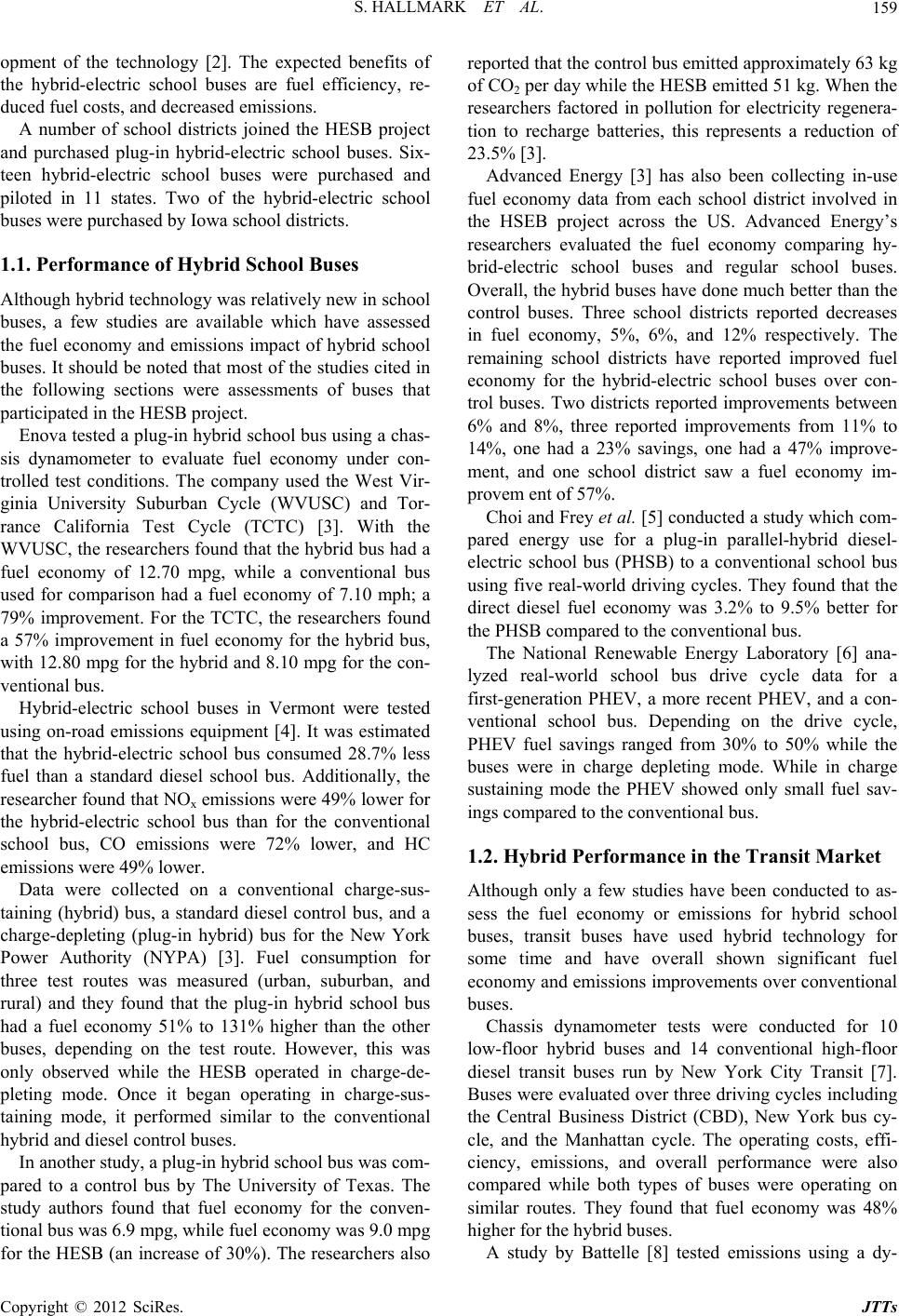
S. HALLMARK ET AL. 159
opment of the technology [2]. The expected benefits of
the hybrid-electric school buses are fuel efficiency, re-
duced fuel costs, and decreased emissions.
A number of school districts joined the HESB project
and purchased plug-in hybrid-electric school buses. Six-
teen hybrid-electric school buses were purchased and
piloted in 11 states. Two of the hybrid-electric school
buses were purchased by Iowa school districts.
1.1. Performance of Hybrid School Buses
Although hybrid technology was relatively new in school
buses, a few studies are available which have assessed
the fuel economy and emissions impact of hybrid school
buses. It should be noted that most of the studies cited in
the following sections were assessments of buses that
participated in the HESB project.
Enova tested a plug-in hybrid school bus using a chas-
sis dynamometer to evaluate fuel economy under con-
trolled test conditions. The company used the West Vir-
ginia University Suburban Cycle (WVUSC) and Tor-
rance California Test Cycle (TCTC) [3]. With the
WVUSC, the research ers found that the hybrid bus had a
fuel economy of 12.70 mpg, while a conventional bus
used for comparison had a fuel economy of 7.10 mph; a
79% improvement. For the TCTC, the researchers found
a 57% improvement in fuel economy for the hybrid bus,
with 12.80 mpg for the hybrid and 8.10 mpg for the con-
ventional bus.
Hybrid-electric school buses in Vermont were tested
using on-road emissions equipment [4]. It was estimated
that the hybrid-electric school bus consumed 28.7% less
fuel than a standard diesel school bus. Additionally, the
researcher found that NOx emissions were 49% lower for
the hybrid-electric school bus than for the conventional
school bus, CO emissions were 72% lower, and HC
emissions were 49% lower.
Data were collected on a conventional charge-sus-
taining (hybrid) bus, a standard diesel control bus, and a
charge-depleting (plug-in hybrid) bus for the New York
Power Authority (NYPA) [3]. Fuel consumption for
three test routes was measured (urban, suburban, and
rural) and they found that the plug-in hybrid school bus
had a fuel economy 51% to 131% higher than the other
buses, depending on the test route. However, this was
only observed while the HESB operated in charge-de-
pleting mode. Once it began operating in charge-sus-
taining mode, it performed similar to the conventional
hybrid and diesel control buses.
In another study, a plug- in hybrid schoo l bus w as co m-
pared to a control bus by The University of Texas. The
study authors found that fuel economy for the conven-
tional bus was 6.9 mpg, while fuel economy was 9.0 mpg
for the HESB (an increase of 30%). The researchers also
reported that the control bus emitted approximatel y 6 3 kg
of CO2 per day while the HESB emitted 51 kg. When the
researchers factored in pollution for electricity regenera-
tion to recharge batteries, this represents a reduction of
23.5% [3].
Advanced Energy [3] has also been collecting in-use
fuel economy data from each school district involved in
the HSEB project across the US. Advanced Energy’s
researchers evaluated the fuel economy comparing hy-
brid-electric school buses and regular school buses.
Overall, the hybrid buses have done much better than the
control buses. Three school districts reported decreases
in fuel economy, 5%, 6%, and 12% respectively. The
remaining school districts have reported improved fuel
economy for the hybrid-electric school buses over con-
trol buses. Two districts reported improvements between
6% and 8%, three reported improvements from 11% to
14%, one had a 23% savings, one had a 47% improve-
ment, and one school district saw a fuel economy im-
provem ent of 57%.
Choi and Frey et al. [5] conducted a study which com-
pared energy use for a plug-in parallel-hybrid diesel-
electric school bus (PHSB) to a conventional school bus
using five real-world driving cycles. They found that the
direct diesel fuel economy was 3.2% to 9.5% better for
the PHSB compared to the conventional bus.
The National Renewable Energy Laboratory [6] ana-
lyzed real-world school bus drive cycle data for a
first-generation PHEV, a more recent PHEV, and a con-
ventional school bus. Depending on the drive cycle,
PHEV fuel savings ranged from 30% to 50% while the
buses were in charge depleting mode. While in charge
sustaining mode the PHEV showed only small fuel sav-
ings compared to the conventional bus.
1.2. Hybrid Performance in the Transit Market
Although only a few studies have been conducted to as-
sess the fuel economy or emissions for hybrid school
buses, transit buses have used hybrid technology for
some time and have overall shown significant fuel
economy and emissions improvements over conventional
buses.
Chassis dynamometer tests were conducted for 10
low-floor hybrid buses and 14 conventional high-floor
diesel transit buses run by New York City Transit [7].
Buses were evaluated over three driving cycles including
the Central Business District (CBD), New York bus cy-
cle, and the Manhattan cycle. The operating costs, effi-
ciency, emissions, and overall performance were also
compared while both types of buses were operating on
similar routes. They found that fuel economy was 48%
higher for the hybrid buses.
A study by Battelle [8] tested emissions using a dy-
Copyright © 2012 SciRes. JTTs